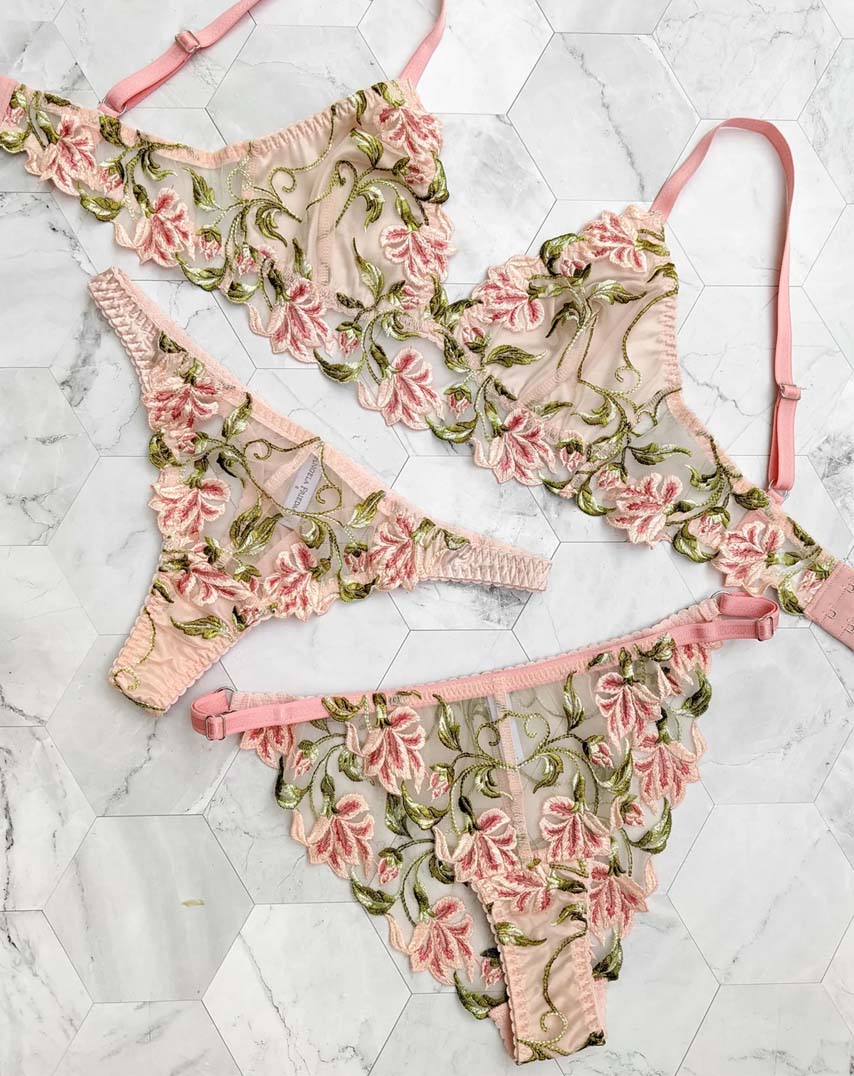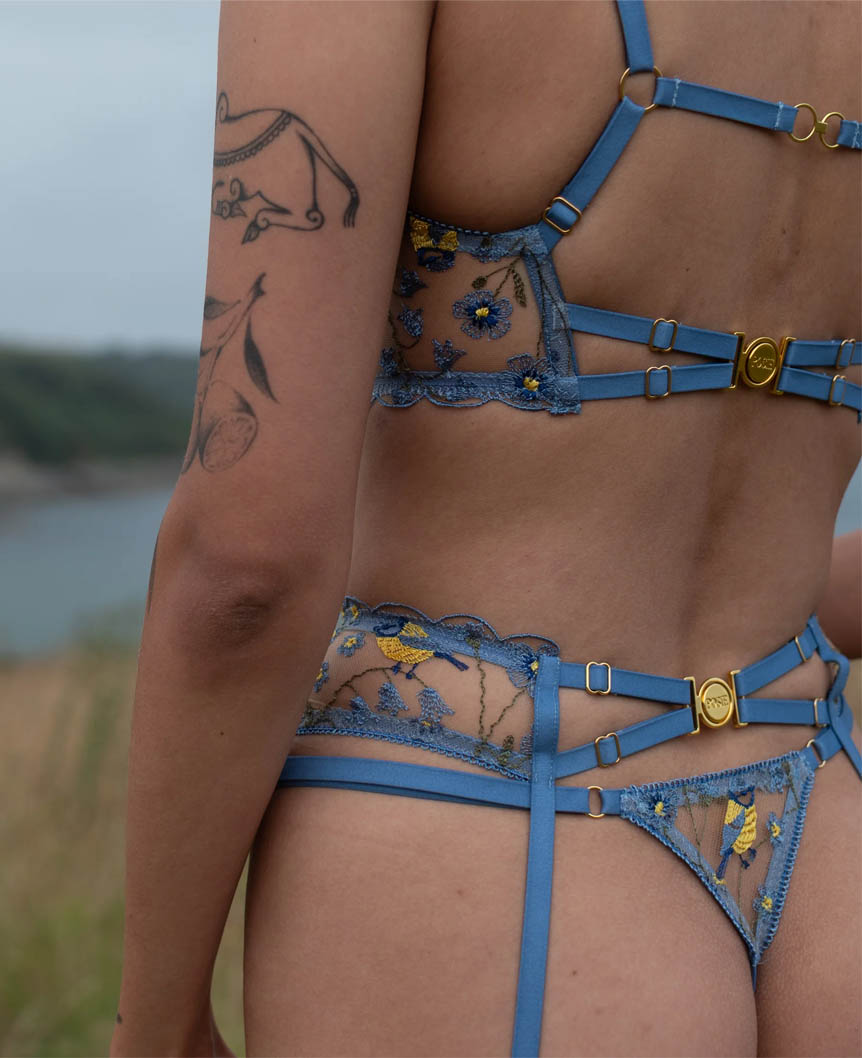Angela Friedman Posie embroidery and silk bralette set.
Have you ever wondered how designers choose to work with different types of embellishments, or why they choose particular fabrics? Some choose lace, others silk, still others layer embroideries or feathers and glimmering pearls in their creations. Over the last year, we sat down with the designers of four stunning brands to learn more about their use of embroidery in particular.
“Whether it’s silk, French lace, delicate embroideries, sheer mesh, or anything else, textiles tell stories.”
Angela Friedman
Embroidered Lingerie vs Lace Lingerie
Embroidered designs are created by stitching onto an existing fabric. Because of that, embroidery tends to be thicker than lace. The relative thickness of the pattern impacts how and where a designer can choose to use embroidered fabric in their designs.
Designer Angela of Angela Friedman frequently works with both materials. She shared that “high quality embroideries (with many dense threads making up the pattern) can be very bulky going into seams… Textiles like the Camellia embroidery couldn’t be used in a multi-seamed underwire bra, because the seams would just be too thick. Lace is more versatile in that way, so you can see in our designs that lace is used in styles with more complex curves like the Heather bralette or Francesca bralette.” You can learn more about the differences between lace and embroidery from Angela here.
Designer Posie, of Posie Lingerie, emphasises the creative control that embroidery offers. She discovered her passion for the medium during university, when she explored floral motifs through free stitch. She described, “with embroidery, I’m not confined to selecting what’s readily available; instead, I have the opportunity to design and bring to life my unique vision.”
Kristen, of Seelanii Lingerie, agrees. While she loves lace, especially French Leavers lace, she rarely sees something that isn’t a simple floral design. She shares, “with embroidery you have an amazing amount of creative freedom. Want to make a bra with cats, crabs or fuchsia flowers? Absolutely.” Her Imago range is a custom machine embroidery, featuring detailed ouvert luna moth bottoms that “would take ages to embroider by hand and would never work out financially as a collection piece.” For this line, a custom machine embroidery is a time-saver.

Different Types of Embroidery
Embroidered fabric can be sourced in a variety of ways. Designers might choose to purchase pre-produced machine embroidered fabric in set designs. They might also work with a specific company to produce machine embroidered fabric in a custom pattern, unique to their brand. Finally, the designer might choose to embroider motifs directly to the fabric in house, allowing them to tailor the exact size, shape, and placement of each design to an individual garment.
Handwork
A much finer quality can be achieved by a skilled handworker. Kristen shared, “From an aesthetic point of view, the choice between machine embroidery and hand embroidery is easy. There is no comparison… You can achieve so many different textures and details with hand stitches that just are not possible with a machine… The only frustration is that it is extremely time consuming.” For example, each of Seelanii’s Queen Ann’s Lace bras have about 1000 French knots. To avoid fatigue, Kristen collaborates with fellow textile artist Małgorzata on her Queen Ann’s Lace line. While Kristen steps in for all custom, bespoke and one-off designs, she jokes that her soul would leave her body if she had to do the same embroidery design for the 100th time – no matter how much she loves the finished piece!

Custom and Pre-Produced Machine Embroidery
Machine work has many benefits for a small business, through its availability, cost effectiveness, and consistent quality. Machine embroidery can be more durable than hand work, as the machines maintain steady tension across the fabric throughout the creation process. Embroidery machines primarily utilise flat, straight stitches such as run stitches, satin stitches and fill stitches. Some commercial machines are equipped to produce additional stitch types or include decorative elements such as sequins.
When producing a bespoke machine embroidery, technical design aspects are key. Ivan, one half of Love & Swans, exercises his knowledge of stitches to “avoid tricky elements that might deform”, making his designs “as durable as they are beautiful.” The brand also balances comfort, at one point developing their own technique for embroidering on stretch mesh to ensure that pieces remain wearable without restricting movement.

Even purveyors of hand embroidery find merit in machine work. Angela has done hand embroidery as a hobby for decades but chose to incorporate machine embroidery in her eponymous brand from the very start. At first, she used embroidery sparingly, overlaid on corsets and the edges of dressing gowns. In 2019, she found a reliable supplier for high quality, soft and durable embroideries, allowing her to focus more heavily on the textile. Now, she designs multiple embroidered lingerie sets in each collection!

She begins her designs with the textiles themselves. She was originally trained in garment construction and patternmaking, which contributes to her deep knowledge of different textile characteristics. The limitations of lingerie also impact her design process. Angela always prioritises sensation, warning that, “you can find the prettiest embroidery in the world, but it’s useless for lingerie if it isn’t soft and gentle against the skin.” She continued, “think the narrowness of a strap or the limited space of a bra band… beginning with the materials helps ensure that the scale of the garment makes sense visually.” When choosing a textile, she always considers its textures, unique colours (or bespoke thread options), interesting patterns… but that’s all secondary to the feeling! No one wants itchy or chafing lingerie.
For Angela, the Camellia embroidery takes all. It’s been both a “personal favourite and a fan fav, becoming something of an obsession in the lingerie community” thanks to its decadent, elegant and playful colours. However, the Flora embroidery represents a close second. Angela shared, “pink is my favourite colour and I love the contrast of pink petals with green foliage.”

Blending Embroidery Techniques
Some designers choose to mix machine and hand embroidery techniques in the same garment. Ivan and Maria, of Love and Swans, found embroidery to be a more versatile and available embellishment than lace. When they started their business, they shared that they “didn’t have a structured plan, nor knew where to source quality lace. We hadn’t even attended a single professional trade show… We realised that artistic embroidery, enhanced with hand embroidery, was the best way to bring our visions to life with the volume of designs we wanted.”

While their unique approach to blended technique sets them apart in the lingerie industry, it also creates difficulty. Maria shared that it can be “challenging to find the right production partners since our pieces need to be high-quality with numerous technical nuances. But by strictly following our detailed production guidelines, we ensure that each batch maintains consistent quality.” The brand works with skilled artisans around the world to bring their creativity to market. But their work hasn’t been without challenges. When a real silver thread in the third production run of their iconic Cygnus line began to unravel, the pair chose to recall the product from customers. They innovated by reinforcing their stitching and improving their techniques to prevent similar issues in the future.
Creative Control Through Custom Machine Embroidery
Posie, of Posie Lingerie, designs her own embroideries, which allow her to “delve into themes and colour palettes that resonate” and give customers “access to unique designs not available elsewhere”. She begins her creative process with the textile, allowing its patterns and textures to guide her in choosing the ideal silhouette to showcase the design.

This can be difficult when designing a fully custom textile. Compared to ready-made stock options, developing a custom design is very costly. Posie’s company previously absorbed development expenses without passing them on to customers, but the cost per metre tends to be higher for custom-designed embroidery which pushes up manufacturing costs. Posie also shared that, “one surprising aspect has been the discrepancy between the envisioned colours on the computer and the actual appearance of the final embroidery samples… Nevertheless, holding the finished embroidery is always a moment of joy, knowing the dedication and hard work poured into its creation. Each time I receive it, I’m eager to craft a lingerie sample straight away!”
This was especially true with the Hydrangea range, Posie’s absolute favourite. Perfecting it took months, but she remembered, “The moment I laid eyes on the initial samples crafted with the fabric, I couldn’t help but gasp in awe”. She described the final design, which “resonated as 100% authentic to my identity as a designer… The intricate beauty and detail captured within the Hydrangea embroidery surpassed my expectations. Notably, it has also emerged as a beloved choice among my customers, which is incredibly gratifying”.

Her passion for textile design is evident in the extensive process she undertook to find a supplier, eventually relying on her network of lingerie designer friends to find a local, family-run business that she describes as a ‘delight to collaborate with’. She was struck by the exceptional softness of their embroideries compared to others in the market.
Before we finish, we would be remiss not to mention the famously bespoke embroidery designs of Studio Pia, who was unavailable for comment:

What unites each of the designers featured today is their excellence in craft, creativity and care. Their meticulous approach to curating beauty is an outstanding testament to the state of the lingerie industry today.
What is your favourite embroidered lingerie design from the article? Are there other designers you’d like us to interview?
